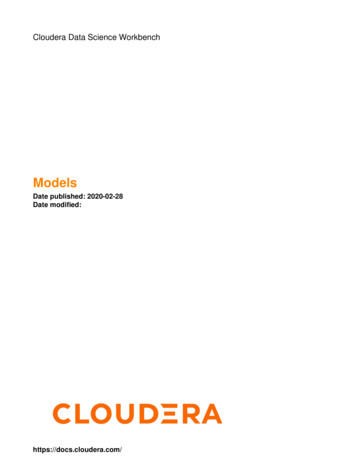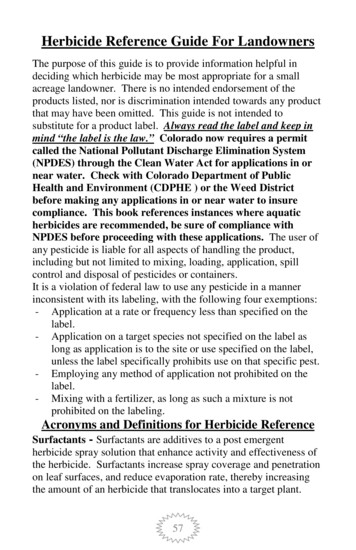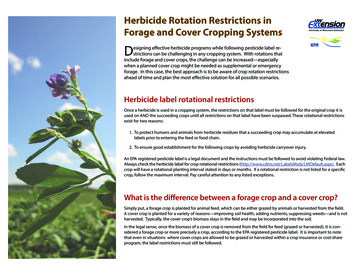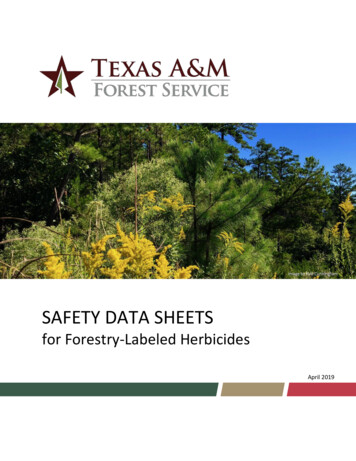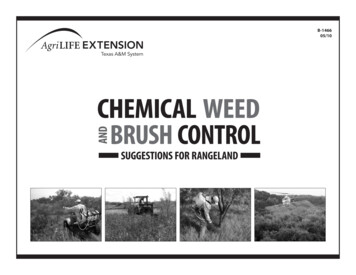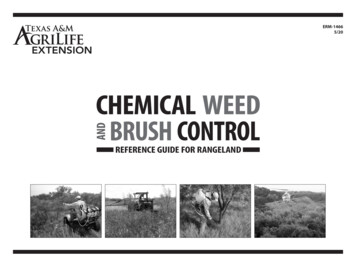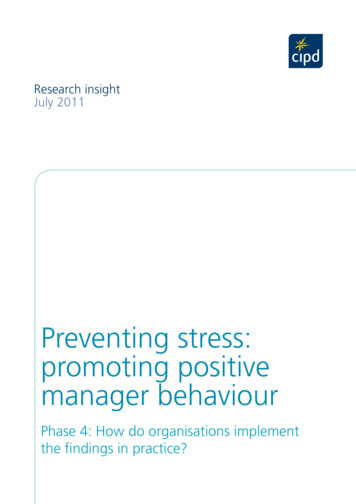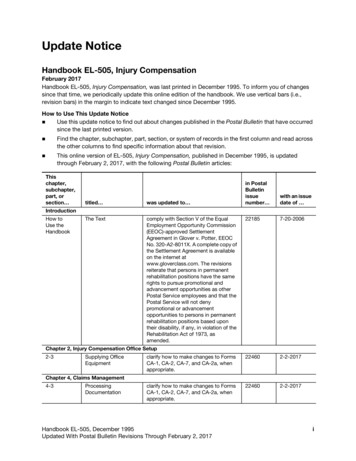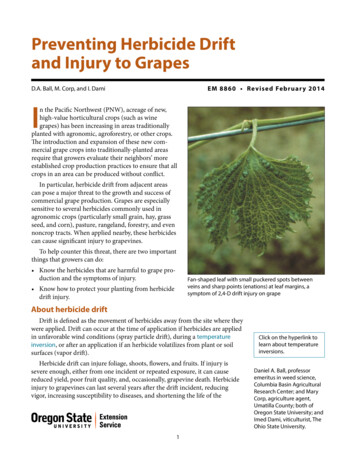
Transcription
Preventing Herbicide Driftand Injury to GrapesEM 8860 Rev is e d Fe b rua r y 2 0 1 4D.A. Ball, M. Corp, and I. DamiIn the Pacific Northwest (PNW), acreage of new,high-value horticultural crops (such as winegrapes) has been increasing in areas traditionallyplanted with agronomic, agroforestry, or other crops.The introduction and expansion of these new commercial grape crops into traditionally-planted areasrequire that growers evaluate their neighbors’ moreestablished crop production practices to ensure that allcrops in an area can be produced without conflict.In particular, herbicide drift from adjacent areascan pose a major threat to the growth and success ofcommercial grape production. Grapes are especiallysensitive to several herbicides commonly used inagronomic crops (particularly small grain, hay, grassseed, and corn), pasture, rangeland, forestry, and evennoncrop tracts. When applied nearby, these herbicidescan cause significant injury to grapevines.To help counter this threat, there are two importantthings that growers can do: Know the herbicides that are harmful to grape production and the symptoms of injury.Fan-shaped leaf with small puckered spots betweenveins and sharp points (enations) at leaf margins, asymptom of 2,4-D drift injury on grape Know how to protect your planting from herbicidedrift injury.About herbicide driftDrift is defined as the movement of herbicides away from the site where theywere applied. Drift can occur at the time of application if herbicides are appliedin unfavorable wind conditions (spray particle drift), during a temperatureinversion, or after an application if an herbicide volatilizes from plant or soilsurfaces (vapor drift).Herbicide drift can injure foliage, shoots, flowers, and fruits. If injury issevere enough, either from one incident or repeated exposure, it can causereduced yield, poor fruit quality, and, occasionally, grapevine death. Herbicideinjury to grapevines can last several years after the drift incident, reducingvigor, increasing susceptibility to diseases, and shortening the life of the1Click on the hyperlink tolearn about temperatureinversions.Daniel A. Ball, professoremeritus in weed science,Columbia Basin AgriculturalResearch Center; and MaryCorp, agriculture agent,Umatilla County; both ofOregon State University; andImed Dami, viticulturist, TheOhio State University.
vineyard. Also, drift to grapes from misapplication of pesticides could resultin illegal residues on the exposed crop. Drift injury can result in substantialeconomic loss.Types of herbicides most harmful to grapesThe herbicide types of greatest concern for grape injury are discussed inthis publication. However, the herbicides listed here are by no means the onlyproducts with potential to injure grapes. Other herbicides with different sitesof action also have some potential to drift and injure grapes, so care is neededduring any herbicide application.Growth regulatorsGrowth-regulator herbicides mimic auxins, which are plant hormonesthat regulate growth and development. This class of herbicides has a greaterpotential to injure grapes.2,4-D, dicamba, MCPA, clopyralid, triclopyr, and a number of othercompounds are classed as growth-regulator herbicides (see Table 1, page 3).The most common growth-regulator herbicides used in the PNW are productscontaining 2,4-D and/or dicamba.Growth-regulator herbicides are used for control of emerged broadleafweeds in wheat, pasture, rangeland, grass seed, corn, and turf. They also arecommonly used by railroad and utility companies and forestry, highway, andmunicipal departments to control unwanted woody plants and broadleafvegetation on rights-of-way.Certain formulations of these herbicides are volatile and can drift as vapor.The potential for vapor drift from 2,4-D and dicamba depends on climaticconditions after application as well as the specific herbicide formulation. Forexample, ester formulations of 2,4-D are more volatile, so their vapor is morelikely to drift than vapor from amine formulations. Because of these esterformulations’ greater drift potential, there are restrictions on their use in certainareas of Oregon and Washington.Grapes are many times more sensitive to growth-regulator herbicidesthan are corn and wheat. Herbicide concentrations of 100 times below therecommended label rate have been reported to cause injury to grapes. Fieldobservations indicate that drift from certain growth-regulator herbicides caninjure grapes half a mile or more from the application site.An array of formulations of growth-regulator herbicides are available forboth commercial and homeowner use. Before considering the use of anyherbicide product, read the herbicide ingredient label to confirm whetherthat product contains a growth-regulator herbicide. A partial list of commongrowth-regulator herbicide trade names, and other herbicides that can injuregrapes, is found in Table 1 (page 3).2Find the Washingtonregulations websitehere: px
Table 1. A partial list of herbicide products that have potential to injure grapes.*Growth regulatorsALS ImidazolinoneAmine yCrossbow**AllyBeyondCredit ExtraCimarron**Rave**Curtail**Ally ExtraPlateauGly StarFormula 40RifleGarlonAmberPursuitGlyfos 4Hi-DepVanquishLandmaster**RaptorGlyproLV 4Cimarron**MCPACimarron**Landmaster**LV ndup SalvoStaraneGleanRT 3SavageStingerHarmonyTouchdownWeedar 64TordonHarmony WeedoneRave***This list is not all-inclusive; other herbicides also may injure grapes.**A prepackaged mixture containing a growth-regulator herbicide as at least one active ingredientGlyphosateALS inhibitorsGlyphosate is applied prior to planting wheat,after harvest, and for maintenance of fallow. Inaddition, it is labeled for use in vineyards. Grapesare not as sensitive to glyphosate as they are to thegrowth-regulator herbicides. However, becauseglyphosate is systemic, it can translocate withingrapevines and kill the growing points. Usually,injury in vineyards results when glyphosate appliedas a directed spray to the ground under grapevinesunintentionally contacts green tissues of the vines.Acetolactate synthase (ALS) inhibitor herbicidesare systemic and may cause injury similar to thatcaused by glyphosate. The ALS inhibitors includethe sulfonylurea herbicides (examples of productsare Ally, Amber, Express, Finesse, Harmony Extra,and Peak; see Table 1) and imidazolinone herbicides(examples of products are Arsenal, Beyond, Plateau,Pursuit, and Raptor).ALS inhibitors are widely used for weed controlin alfalfa, pea, clover, and wheat, and for noncropland weed control. They are applied both beforeand after planting at extremely low use rates.Glyphosate usually is less of a problem thana growth-regulator herbicide because it is notvolatile. Nevertheless, glyphosate can drift inwindy conditions and injure grapes. Glyphosatedrift from sprayers also has been implicated indamage resembling that caused by growth-regulatorherbicides.The high biological activity of ALS inhibitorsincreases the likelihood of drift injury to grapes,especially if a temperature inversion allows smallspray particles to remain suspended in the air forextended periods. However, because of the lowvolatility of ALS-inhibitor herbicides, injury tograpes from this type of herbicide generally occursonly from nearby applications.Glyphosate is the active ingredient in Roundup and similar herbicide products. Different formula tions of glyphosate are available; they will be listedon the herbicide ingredient label as one of varioussalt formulations of N-(phosphonomethyl) glycine.See Table 1 for a list of some products that containglyphosate.3
Herbicide drift injurySpring applications of growth regulators, ALSinhibitors, and glyphosate that move off target mayaccumulate in the growing points of grapes, where injurysymptoms first appear. Fall applications that result in driftmay accumulate in roots. The type and severity of injuryto grapes depends on the concentration of the herbicide,time of exposure and corresponding vine growth stage,and grape variety.Time of exposure is important, as injury is muchmore severe during periods of rapid grape growth. Thepossibility for injury can be reduced considerably ifpotentially injurious herbicides are applied in early springwhen grapes are still dormant (prior to bud break); so,be sure you know the timing of bud break in your areato help prevent grape injury. Bud break generally occursaround early to mid-April in the Walla Walla Valley area,but the timing of bud break varies depending on thespecific region.AIf exposure occurs during the period of rapid shootgrowth between bud break and bloom, grape injury canbe severe. Field observations indicate that herbicide driftexposure before bloom but after bud break can causeflower abortion, curling of shoot tips, cessation of shootgrowth, and regrowth of deformed leaves after exposure.Mid- and late-season exposure usually causes minorleaf deformation, since most shoots are fully grown andthere are few developing leaves to react to the herbicide.However, exposure of developing berries to herbicidesmay greatly delay or even prevent ripening.The sensitivity of grapes to herbicide drift also dependson the grape cultivar. Nonetheless, with severe andrepeated exposure to herbicide drift, all cultivars arevulnerable.Growth-regulator injury symptomsBFigure 1. 2,4-D drift injury symptoms: (A) Fan-shapedInjury from growth-regulator herbicides usuallyleaf with small puckered spots between veins andsharp points (enations) at leaf margins. (B) Zigzagappears within 2 days of the drift incident. Symptomsshoot growth with shortened internodes.of 2,4-D injury include characteristic fan-shaped leaveswith sharp points at leaf margins, epinasty (downwardbending of leaves), leaf strapping with deep sinuses (leafmargin indentations), and leaf puckering with constricted veins that may beslightly chlorotic (Figure 1). Research in Washington with Concord grapes hasfound that 2,4-D affects fruit quality, including fruit color, sugar levels, and acidcontent. Dicamba injury usually causes leaf cupping and a distinct marginalband of restricted growth (Figure 2, page 5).4
Shoot tips seldom resume growth after they havebeen injured by growth-regulator herbicides, but lateralscontinue to grow. The result is a very bushy vine with ashade canopy and poor fruit exposure. Growth-regulatorinjury is particularly severe when the same grape plantingis exposed to multiple incidents over a period of years.Symptoms of fanleaf degeneration, a viral disease, canresemble those caused by growth regulators.Glyphosate and ALS-inhibitor injury symptomsSymptoms vary, depending on the timing of the driftincident, and usually take 2 to 3 weeks to appear. Thefirst symptom usually is yellowing of the growing points,followed by necrosis and death of the growing points(Figure 3, page 6). As a result, apical dominance may bebroken, resulting in growth of numerous lateral shoots(bushy growth). Other symptoms include arrow-shaped,cupped, and upward-curled leaves, shortened internodes,and occasionally interveinal chlorosis (Figures 3 and 4,page 6).AFall uptake of glyphosate may result in symptoms thefollowing year, including stunting of early shoot growth,leaf chlorosis and distortion, very short internodes,abundant lateral shoots, and aborted flowers. These earlyspring symptoms may be confused with viral or fungaldiseases (for example, Eutypa dieback).Grape root injury can occur from either glyphosateor ALS inhibitors, although the long-term implicationsof this type of root injury are unknown. It is generallybelieved that root injury is more likely from ALSinhibiting herbicides than from glyphosate, sinceglyphosate is rapidly inactivated when it comes in contactwith soil.BFigure 2. Dicamba drift injury symptoms: (A) Leafcupping downward. (B) Leaf cupping upward.Protection from herbicide drift injuryBoth grape growers and nearby growers of other cropscan take steps to reduce the risk of herbicide drift injuryto grapevines.Avoid making herbicide applications during sensitive periods of grape growthand development.Everyone who uses potentially injurious herbicide products should knowwhether and where grapes are being grown in their vicinity and when grapesare in sensitive developmental stages. (The most sensitive stages of grapedevelopment start with bud break in early spring through flowering and fruit set.)Maintain good relations with neighbors.Grape producers should make sure that neighbors within approximately a halfmile radius around their vineyard are aware that vines are growing nearby andthat they are sensitive to some herbicides. Be sure that state and county highway5
departments, utility companies, and other agencies thatmight spray rights-of-way or roadsides know where yourvineyard is. If rights-of-way or roadsides run throughyour property, keep them free of weeds so they are lesslikely to be sprayed. Encourage your neighbors to usedrift-reduction spray nozzles (nozzles that produce largedroplets) and to select herbicides that are less likely toinjure grapes.Minimize drift injury from herbicides used in thevineyard.Glyphosate is registered for use in nonbearing andbearing grapes as a directed spray. However, if it is notapplied properly, severe damage can occur. To avoidinjury, grape growers should observe the followingguidelines.A Avoid glyphosate contact with any green parts of thevine or through drift. If possible, avoid summer and fall applications (whengrapes are most susceptible to injury). Avoid glyphosate applications when shoots beginto trail, especially with downward shoot-trainingsystems. Use a shield mounted to a wand for a backpacksprayer application or a commercial shielded sprayersuch as a dome sprayer. Avoid spraying in windy conditions or during temperature inversions. Use drift-reduction nozzles (for example, drift-guardor air induction types) that operate at lower pressure(15 to 30 psi) and produce large droplets.BFigure 3. Glyphosate injury symptoms: (A) Distortedleaves. (B) Lateral shoot growth with unusual burst oflatent buds on nodes, short internodes, and distortedleaves. Use grow tubes to protect the green shoots of firstyear vines from herbicide contact. If you practice chemical weed control in your vineyard, begin the weed management program withpreemergence herbicides (consult the PNW WeedManagement Handbook) and follow up with postemergence herbicides before bud break. In midseason, use a contact herbicide (not systemic)to treat weed escapes. Examples are products such asGramoxone (paraquat) or Rely (glufosinate). If you use 2,4-D in your vineyard, apply it beforeactive shoot growth occurs, use low spray pressures,and be extremely careful to avoid treatment whenweather conditions favor drift, such as during hightemperatures, breezy conditions, and temperatureinversions.6Figure 4. ALS inhibitor injury symptoms fromsulfonylurea herbicide spray drift: chlorosis of leafveins and change in leaf appearance from smooth tocrinkled.
Other herbicide drift resourcesQuestions and Answers About Vineyard Injury fromHerbicide Drift. Kansas State University. iagnosing Herbicide Injury on Garden andLandscape Plants. ID-184-W. Purdue Plant & PestDiagnostic Laboratory. http://www.extension.purdue.edu/extmedia/ID/ID 184 W.pdfWashington Pesticide Management Division(Washington Department of Agriculture,509-225-2647, toll-free 1-877-301-4555). Directinvestigations of suspected Washington drift incidents here.Leaf Index and Severity Rating, Washington StateUniversity. http://feql.wsu.edu/eb/Oregon Department of Agriculture (503-986-4653).Direct investigations of suspected Oregon driftincidents here.Use pesticides safely! Wear protective clothing and safety devices as recommended on thelabel. Bathe or shower after each use. Read the pesticide label—even if you’ve used the pesticide before.Follow closely the instructions on the label (and any other directionsyou have). Be cautious when you apply pesticides. Know your legal responsibilityas a pesticide applicator. You may be liable for injury or damageresulting from pesticide use.All photos in this publication by Imed Dami, The Ohio State UniversityTrade-name products and services are mentioned as illustrations only. This does not mean that the Oregon State University Extension Service either endorsesthese products and services or intends to discriminate against products and services not mentioned. 2014 Oregon State University. This publication was produced and distributed in furtherance of the Acts of Congress of May 8 and June 30, 1914. Extensionwork is a cooperative program of Oregon State University, the U.S. Department of Agriculture, and Oregon counties. Oregon State University ExtensionService offers educational programs, activities, and materials without discrimination based on age, color, disability, gender identity or expression, geneticinformation, marital status, national origin, race, religion, sex, sexual orientation, or veteran’s status. Oregon State University Extension Service is an EqualOpportunity Employer.Published March 2004. Revised February 2014.7
herbicide product, read the herbicide ingredient label to confirm whether that product contains a growth-regulator herbicide. A partial list of common growth-regulator herbicide trade names, and other herbicides that can injure . Hi

